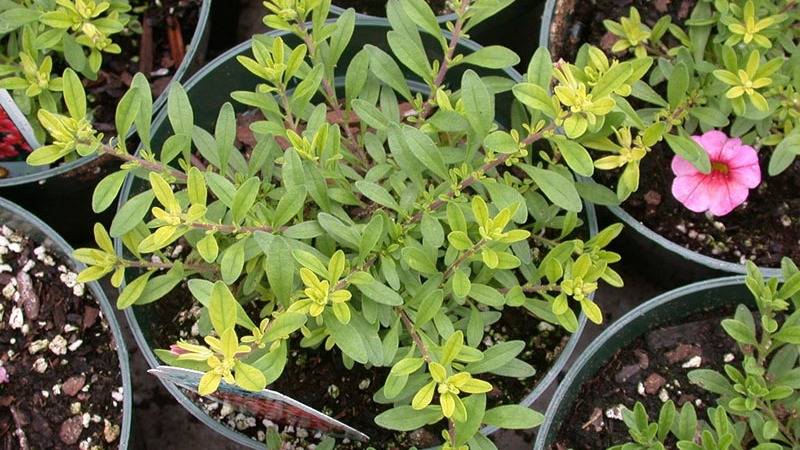It is not uncommon for growers to experience an iron deficiency in crops that prefer lower growing media pH, such as bacopa, calibrachoa, diascia, dianthus, nemesia, pansy, petunia, scaevola, snapdragon, verbena or vinca.
Typical symptoms include interveinal chlorosis of the new leaves (yellow leaves with green veins). These symptoms can also be caused by other cultural problems, micronutrient deficiencies, root diseases, excessive watering, etc. The best way to be sure is to examine the crop for root disease. If the root system is healthy, then send in media and tissue samples for laboratory analysis to confirm the source.
Correcting Iron Deficiency
If iron deficiency is confirmed, there are two possible causes.
- The growing medium pH is too high (above 6.2). Correct the growing medium pH by injecting acid and/or switching to a higher potential acidity fertilizer.
- Iron application is insufficient. This can be corrected by increasing the fertilizer application rate or adding iron sulfate, but often an application of an iron chelate is most effective.
Iron Chelate Forms
Why use a chelated form of iron? As the pH of the growing medium rises above 6.2, iron becomes less available to the plant even though it is still present. Chelates are electrically charged, organic molecules that hold the iron, but release the iron to the plant even if the growing medium pH is high. Not all chelates work the same. According to the publication, “Understanding pH Management for Container Grown Plants” by William Argo and Paul Fischer, the best chelate for the release of iron over the highest pH limit is iron-EDDHA. Here is a comparison:
Table 1. Comparison of chelates.
| Chelate |
Upper pH Limit |
Products available |
% Iron |
Reliability |
|---|
| Iron - EDTA |
7.0 |
Found in most water-soluble fertilizers, Sequestrene Fe |
13% |
OK |
| Iron - DTPA |
7.5 |
Sprint 330, Sequestrene 330 |
10% |
Better |
| Iron - EDDHA |
9.0 + |
Sprint 138, Sequestrene 138 |
6% |
Best |
Applying Iron Chelates
Regardless of whether you use the DTPA or EDDHA, add 5 ounces of either product to each gallon of fertilizer concentrate and inject at a ratio of 1:100. This will apply 37.5 ppm iron and 45 ppm iron, respectively. Use the following tips for iron chelates:
- Apply when the media is dry to maximize absorption of the product.
- Apply in the morning and then rinse the foliage to prevent staining or burning the foliage.
- Do not apply to geraniums, New Guinea impatiens, marigolds, pentas, lisianthus or other high-iron sensitive crops.
- One Fe-EDDHA application is effective for one month, depending on growing medium pH and leaching.
- One Fe-DTPA application does not last as long as Fe-EDDHA, so it may need to be applied more frequently. Fe-DTPA application rates may need to be higher to obtain the same results.
- Store the product and mixed solutions in the dark as sunlight will degrade the chelate.
- If pH of the growing medium is high, apply potentially acidic fertilizers or use acid injection.
Remember, iron chelates are best applied as drenches and work well to correct iron deficiency problems.
